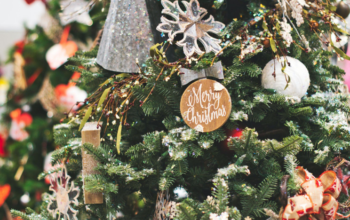The Environmental Impact of Artificial Christmas Garlands: What You Need to Know
Artificial Christmas garlands are decorative wreaths made of synthetic materials used to decorate homes and public spaces during the holiday season. They come in various shapes, sizes, colors, and styles and are often adorned with lights, bells, and other ornaments to add to their festive appeal.
While artificial garlands offer a convenio and add sparkle and cheer to your Christmas decor, they have a significant environmental impact that cannot be overlooked. Their production involves using non-biodegradable materials and harmful chemicals, contributing to air and water pollution and the depletion of natural resources.
Environmental Impact of Artificial Christmas Garlands
The production of artificial Christmas garlands involves using PVC plastic, which is not biodegradable and takes hundreds of years to decompose. PVC plants also emit toxic compounds such as dioxins, phthalates, and vinyl chloride, which can harm both humans and the environment.
Additionally, producing PVC requires the extraction of non-renewable fossil fuels, such as petroleum, which contributes to greenhouse gas emissions and climate change. The energy used to manufacture and transport artificial garlands also adds to their carbon footprint.
Once the garlands are made, they often come wrapped in plastic packaging that is also harmful to the environment. When disposed of, the wreaths end up in landfills, which take up space and release toxins into the surrounding soil and water.
Overall, the environmental impact of artificial Christmas garlands is significant and cannot be ignored. However, there are ways to make eco-friendly choices regarding holiday decor.
Eco-Friendly Alternatives to Artificial Christmas Garlands
Many eco-friendly options exist if you’re looking for alternatives to artificial Christmas garlands. Here are some ideas:
1. Natural Christmas Garland – Instead of synthetic materials, consider making your Christmas garland using natural materials such as pinecones, holly, and ivy. These materials are biodegradable and can be composted after use.
2. LED Lights – If you’re looking for extra holiday sparkle, consider using LED instead of traditional incandescent lights. LED lights are more energy-efficient and have a longer lifespan, reducing waste generated.
3. Upcycled Decorations – Consider upcycling items you already have rather than buying new ornaments and decorations each year. For example, old Christmas cards can be turned into garlands, and fabric scraps can be made into tree skirts.
4. Renting Decorations – If you don’t want to invest in holiday decorations that will only be used for a few weeks each year, consider renting them. Many local rental companies offer holiday decor rentals, including Christmas trees and wreaths.
In Conclusion
As we get ready to celebrate the holiday season, it’s essential to remember the impact our holiday decorations can have on the environment. So while it may be tempting to opt for the convenience and affordability of artificial Christmas garlands, it’s essential to consider the harm they can cause.
By making eco-friendly choices regarding holiday decor, we can reduce our environmental footprint and help protect the planet for future generations. So, this holiday season, let’s all do our part to spread some cheer while being kind to the environment.




